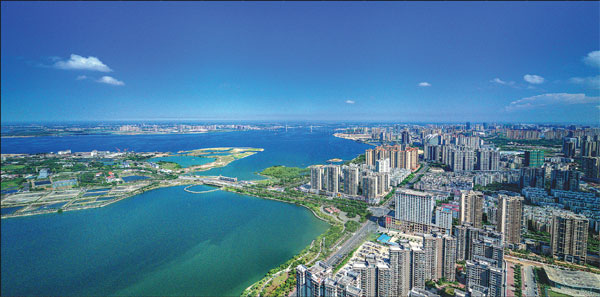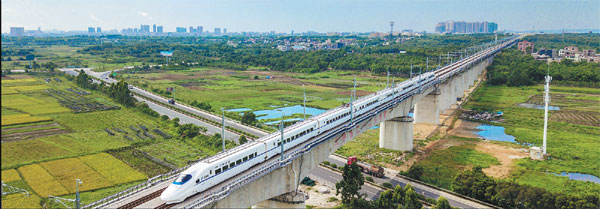Home> News
On track to bring growth to Zhanjiang
Multiple high-speed railways will shorten journeys to nearby regions and help develop closer business ties across the country, Chen Hong reports.
With a newly approved railway hub development plan, Zhanjiang in South China's Guangdong province is gaining new momentum to accelerate its economic growth to become a regional leader.
According to the new plan, five high-speed rail lines will intersect in the downtown area of the southern port city, cutting the journey time to other cities in the province and more efficiently connecting Zhanjiang with the rest of the country.

Scenery of Zhanjiang Bay in Guangdong province. [Photo by Lang Shuchen/For China Daily]

Left: The transport network of Zhanjiang will be built with ecological protection in mind. [Photo by Jin Yafen/China Daily]; Right: A local fisherman collects his catch in Zhanjiang. [Photo provided to China Daily]
"Transportation has been a critical weakness of Zhanjiang that hampers the city's development. The plan provides a great remedy to the issue," said Mayor Jiang Jianjun in a press briefing Monday, describing the approval as "very significant" to the city.
Before, the transportation of Zhanjiang could hardly match its position, with the city designated by the provincial government as a sub-center of Guangdong and by the central government as a core city of the urban agglomeration of the Beibu Gulf, given its strategic location at the junction of Guangdong, Hainan provinces and the Guangxi Zhuang autonomous region.
Just one year ago, the first high-speed rail line started operation to link Zhanjiang with Guangzhou, capital of Guangdong, shortening the journey time of five to seven hours by car to three hours by train.
"We are not just developing Zhanjiang alone, we also work on the role of the province's sub-center to hopefully lead the growth of the surrounding cities, including the cluster of Zhanjiang, Maoming and Yangjiang and the urban agglomeration of the Beibu Gulf, as well as to serve the strategic needs of Hainan," Jiang said.
Hub plan unfolded
The local government proposed the rail hub plan to China State Railway Group, a State-owned enterprise that is authorized by the State Council to invest in and run the country's massive rail network, in July 2017 and got the approval on June 20, 2019.
It becomes the third rail hub of Guangdong, following Guangzhou and Shenzhen, and the 51st in the country, said the mayor.
"The five high-speed railways can prop up the industrial, urban and quality development of the export-oriented economy of Zhanjiang in the future," Jiang noted.
Besides the existing high-speed rail, the planned Guangzhou-Zhanjiang rail line, with a designed speed of 350 kilometers per hour, will further cut the time to Guangzhou and Shenzhen to two hours, which will help the city better integrate with the Guangdong-Hong Kong-Macao Greater Bay Area, Jiang said.
Westward, the city will be more closely connected with the urban conglomeration of the Beibu Gulf when the Hepu-Zhanjiang line is put through, as the travel time will be kept within three hours.
The two lines are expected to start construction by the end of this year and be put into operation by 2025, according to China Railway Eryuan Engineering Group, the railway design and planning company.
Southward, the city will be able to reach Haikou, capital of Hainan from its downtown in about two hours when a high-speed rail line is ready, which will allow Zhanjiang to take the opportunities arising from Hainan's role as a free trade zone.
The line is expected to start construction by the end of 2020, according to the company.
The final rail line, which is designed to connect Zhangjiajie, a famous scenic city in Central China's Hunan province, with Zhanjiang, is still at the early stage of research and has no timetable for construction yet, he added.
Investment boom
The new high-speed railways, which have been an important consideration for some investors, can help Zhanjiang to lure more investment, Nie Bing, director of the city's development and reform bureau, told reporters Wednesday.
Zhanjiang has attracted a group of large companies, including BASF, Sinopec, CNOOC, Baosteel, China Resources, OCT, China Shipbuilding Industry Corporation and China Merchants Group, over the past few years, especially after the operation started on its first high-speed rail line in July last year, Nie said.
When Zhanjiang can more rapidly access the Pearl River Delta and the Beibu Gulf cities with the operation of new rail lines in the near future, it will become a more important investment destination for investors from those areas, Nie noted.
"We have a favorable geographic location, abundant natural resources and excellent eco-environment. Big investors can accelerate the transition and upgrade the industry of Zhanjiang and promote its fast development as a result," said Nie.
More importantly, convenient transportation can attract an increasing number of talent to Zhanjiang and that is a critical element for the city's development, Nie said.
According to the mayor, the city will continue to put priority on the upgrading of its transport network, including the construction of highways and city expressways, a new airport and a deeper waterway.
According to the urban planning, the new airport of Zhanjiang is expected to be put into service in 2020 with the old one closed to make space for a new railway terminal in the downtown of the city, where five high-speed rail lines will meet.
"Because of the special arrangement, it's feasible to build the railway terminal in the city center rather than in the suburb, which can provide better convenience to travelers," said Yan Haomin, who is in charge of the railway planning of Zhanjiang with China Railway Eryuan Engineering Group.
What they say
I'm very happy that more high-speed railways will pass through Zhanjiang to link the city with more regions in South, Central and North China. It's good news for BASF because we cannot only attract more talent from around the country to help develop Zhanjiang but also more clients to settle here.
Song Yongxin, deputy general manager of BASF integrated Site (Guangdong)
The five high-speed railways in Zhanjiang will help it become a central city in Guangdong province, which is good for local companies to attract more promising talent. The traffic network will improve the city's capacity in freight transport and thus decrease the transportation cost of companies. It's also helpful to attract more companies to invest in Zhanjiang and optimize the downstream products' supply chain.
Deng Qingsong, project manager from Zhongke (Guangdong) Refinery & Petrochemical
Construction of the high-speed railway network in Zhanjiang can greatly contribute to the well-being of local people. The construction should protect the natural landscape and ecological conditions. For example, the selection of stations should avoid natural reserves, drinking water reserves and scenic spots. Besides, methods should be taken to reduce noise and control dust. All in all, the construction and operation of railways should have the least impact on the surrounding environment.
Lin Weizhong, deputy director of the department of ecology and environment of Zhanjiang
When the railway hub in Zhanjiang is completed, the convenient transportation can make the city more attractive to high-level professionals and top companies. It can serve the current strategy to build a modern coastal economic belt. It can also help build a better ecosystem for the iron and steel industry and promote high-quality development in the region.
Jiang Yuhe, deputy director of the logistic department at Baosteel Zhanjiang Iron and Steel

A high-speed train passes through Zhanjiang. [Photo by Lang Shuchen/ For China Daily]

 Print
Print Mail
Mail 5G construction supports Zhanjiang's high-quality development
5G construction supports Zhanjiang's high-quality development
 Acting mayor inspects project construction in Xuwen, Leizhou
Acting mayor inspects project construction in Xuwen, Leizhou Zhanjiang island an "egret paradise"
Zhanjiang island an "egret paradise"  Dancing egrets add vitality to Xiashan
Dancing egrets add vitality to Xiashan